Vision 2025 - National Research Centre for Grapes
Vision 2025 - National Research Centre for Grapes
Vision 2025 - National Research Centre for Grapes
You also want an ePaper? Increase the reach of your titles
YUMPU automatically turns print PDFs into web optimized ePapers that Google loves.
EXECUTIVE SUMMARY<br />
THE INDIAN GRAPE SCENARIO<br />
Presently the area under grape cultivation in India is about 60,000 ha (FAO Stat 2005) with the<br />
production in the range of 1.2-1.6 and 0.55 - 0.65 million MT of fresh grape and raisin, respectively.<br />
India has achieved a reasonably high level of productivity of grapes but at the cost of maintaining<br />
the quality as per the international standards and shelf life. The availability of fruits is confined to<br />
specific periods of year and the prices are ruled by the market availability. Low temperature storage<br />
of fruits is not economical and hence not in practice <strong>for</strong> domestic market while raisin making solves<br />
the problem of grape perishability to some extent but the price realization is not much. Further, grape<br />
has to compete with other fruits during their availability period in the market <strong>for</strong> consumer<br />
preference.<br />
In spite of this, the grape growers as an organized sector are persisting with grape cultivation and<br />
look <strong>for</strong>ward to new technologies <strong>for</strong> sustaining the productivity, improving quality, reducing the<br />
cost of cultivation, extending the area and the season of harvest, high value end-uses especially wine<br />
making. Few State Governments in the country have favourable policies <strong>for</strong> the promotion of wine<br />
production in the <strong>for</strong>m of wine parks in industrial complexes and setting up of wine training institutes<br />
and other economy packages. Hence, optimum economic yield of quality grape, price and their cost<br />
of production, the seasons of their availability, and diversification <strong>for</strong> value added products like<br />
raisin, wine and juice are the key words in Indian viticulture. This <strong>Centre</strong> has, there<strong>for</strong>e, after<br />
thorough deliberations with the grape growers, exporters, raisin and wine producers; advisory bodies<br />
like <strong>Research</strong> Advisory Committee and Quinquennial review Team, <strong>for</strong>mulated a number of focused<br />
research programmes to address these key issues.<br />
RESOURCES AVAILABLE WITH THE INSTITUTE<br />
The <strong>Centre</strong> has about 46.78 ha of land area, out of which 1.6 ha is under buildings, 1.2 ha is under<br />
roads, 1.2 ha under polyhouses and nursery, 4.8 ha under germplasm and new hybrid / clones; 8.4 ha<br />
planted with table grapes <strong>for</strong> experiments. 4.0 ha is under preparation to be planted with wine grape<br />
varieties <strong>for</strong> new experiments. The <strong>Centre</strong> has ten well-equipped laboratories with basic and<br />
sophisticated equipments, however, other essential equipments <strong>for</strong> the new proposed research<br />
activities are included in the XI Plan EFC document of the Institute.<br />
RESEARCH ACHIEVEMENTS OF THE INSTITUTE<br />
In the first decade of its existence, the Center has made significant achievement in collecting the<br />
grape germplasm within the country and augmenting it with that from abroad. Morphological and<br />
molecular characterization of the accessions is in progress and will be completed within a short time.<br />
Sources of resistance to downy mildew disease are identified and the in<strong>for</strong>mation is being utilized<br />
<strong>for</strong> resistance breeding programme and to develop molecular markers <strong>for</strong> downy mildew resistance.<br />
Germplasm sources with multiple disease resistance will be known shortly. Evaluation <strong>for</strong> other<br />
parameters is in progress. A database was created, and copyrighted, to manage all this in<strong>for</strong>mation.<br />
Hybrids developed at this <strong>Centre</strong> are being evaluated in the field <strong>for</strong> various traits, while promising<br />
new clones viz. A 17/3, KR-W, A18/3 etc. and popular imported varieties viz. Red Globe, Crimson<br />
Seedless, Fantasy Seedless and Italia are under multilocational evaluation in grower's vineyards.<br />
Dogridge was found a promising rootstock <strong>for</strong> Thompson Seedless and Tas-A-Ganesh grape under<br />
salt and drought conditions. Other potential rootstocks like 110 R, B2 - 56, 1103 P, 99 R, 140 Ru,





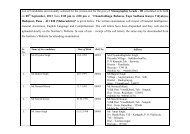
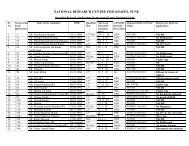

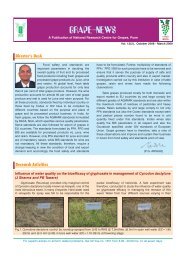

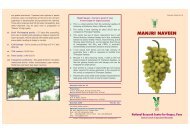
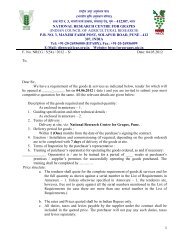



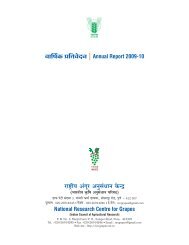
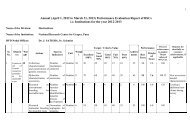
![mj]mJ{V cmcH$m{irM{ (_mBQâ¤>g) oZ`ÃÃU](https://img.yumpu.com/33367555/1/190x127/mjmjv-cmchmirm-mbqag-ozaau.jpg?quality=85)